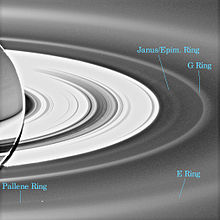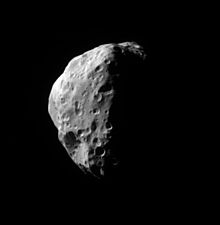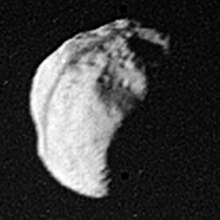Epimetheus (moon)
| Epimetheus | |
|---|---|
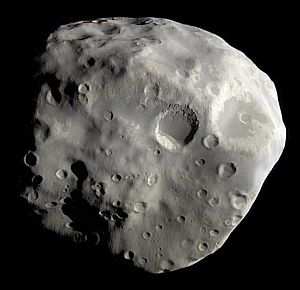
|
|
| Epimetheus' south polar region, taken by the NASA -Raumsonde Cassini on 3 December 2007 from 37,400 kilometers away. | |
| Provisional or systematic name | S / 1980 S 3 |
| Central body | Saturn |
| Properties of the orbit | |
| Major semi-axis | 151.410 ± 10 km |
| Periapsis | 149,926 km |
| Apoapsis | 152,894 km |
| eccentricity | 0.0098 |
| Orbit inclination | 0.351 ± 0.004 ° |
| Orbital time | 0.694333517 d |
| Mean orbital velocity | 15.8 km / s |
| Physical Properties | |
| Albedo | 0.73 ± 0.03 |
| Apparent brightness | 15.6 mag |
| Medium diameter | 113.4 ± 6.2 (135 × 108 × 105) km |
| Dimensions | 5.304 ± 0.013 x 10 17 kg |
| surface | ≈ 40,400 km 2 |
| Medium density | 0.69 ± 0.11 g / cm 3 |
| Sidereal rotation | 0.694333517 days |
| Axis inclination | 0.0 ° |
| Acceleration of gravity on the surface | 0.0078 m / s 2 |
| Escape speed | 32.0 m / s |
| Surface temperature | ≈ −195 ° C (78) K |
| discovery | |
| Explorer | |
| Date of discovery | 18th December 1966 |
| Remarks | Co-ordinate moon with Janus |

|
|
| The positions of the inner moons of Saturn in Saturn's ring system, from inside to outside Pan, Atlas, Prometheus, Pandora, Janus & Epimetheus, Mimas, Enceladus, Tethys, Dione and Rhea | |
Epimetheus (also Saturn XI ) is the seventh, eighth and tenth largest of the 82 known moons of the planet Saturn . The co-ordinate moon shares its orbit with Janus , with whom it changes orbits every four years.
Discovery and naming
Epimetheus was discovered on December 18, 1966 by the astronomer Richard L. Walker . On December 15, 1966, Audouin Dollfus had already discovered a new moon near Saturn, and suggested that Janus name it . The moon, discovered by Richard L. Walker three days later, was initially believed to be the same object.
However, the object showed unusual behavior on the path. In October 1978, Stephen M. Larson and John W. Fountain found that the observations could best be explained by the presence of two separate bodies sharing the same orbit. However, it turned out to be very difficult to break down the orbits of the moons from the observation data.
In 1980 this assumption was confirmed when the Voyager 1 space probe flew by. Walker therefore officially shares his discovery with Larson and Fountain. The body recorded by Voyager was initially named S 3 by the International Astronomical Union (IAU) in 1980 (→ below ). Epimetheus is the 11th moon discovered by Saturn .
The name Epimetheus was officially given on September 30, 1983. It was also at this point that the name Janus was officially recognized, although it has been in use since 1966.
The moon was named after the titan Epimetheus , son of Iapetus and Clymene , brother of Prometheus , Menoitius and Atlas , and husband of Pandora and, according to later traditions, the father of Pyrrha (wife and cousin of Prometheus' son Deucalion ) from Greek mythology .
The name means the one who thinks afterwards , which is to be understood as an antonym to the name of Prometheus ( the one who thinks before ).
According to the naming conventions of the IAU, Janus names with a connection to the mythical twin pair Castor and Pollux are used for surface structures.
Track properties
Orbit
Epimetheus orbits Saturn on a prograde , almost perfectly circular orbit at an average distance of 151,410 km to 151,460 km (approx. 2.512 to 2.513 Saturn radii) from its center, i.e. 91,142 km to 91,192 km above its cloud ceiling. The orbital eccentricity is 0.0098, the web is 0.351 ° relative to the equator of Saturn inclined , that is almost exactly in the equatorial plane of the planet. Due to the low eccentricity, the orbit varies in distance to Saturn by only around 3,000 km.
The orbit of the next inner moon Pandora is on average 9,690 and 9,740 km from the orbits of Epimetheus and Janus, the distance of the orbit of the next outer moon Aegaeon is on average about 16,000 km.
Epimetheus orbits Saturn in 16 hours, 39 minutes and 50.6 seconds. This corresponds to a little more than the orbital period of Jupiter's moon Thebe and lies between the Uranus moons Perdita and Puck . The orbital times of Epimetheus and Janus differ by only 28.1 seconds. Epimetheus and Janus need about 1 hour and 34 to 35 minutes longer than their inner neighbor Pandora to complete one cycle.
Orbit behavior of Epimetheus and Janus
Epimetheus is co-ordinate with the moon Janus , that is, the two moons run on almost the same orbits around Saturn. Their mean distances from the planet differ only 50 km, which is less than the diameters of both moons. About every four years there is a close encounter between the two moons, which then influence each other through their gravity . According to Kepler's laws , the inner moon, whose orbit is a total of 28.1 seconds (1/4 degree per day) faster, is accelerated and moves to a higher orbit, which in turn slows it down. The outer one is slowed down, moves to a lower orbit and is thereby accelerated. In this way, Epimetheus and Janus swap their orbits during this 100-day process, but do not overtake each other and never approach each other by more than 15,000 km. Since Epimetheus has only a quarter as much mass as Janus, he always has to carry around 80% of the total change in orbit. The orbital relationship of the two moons can be understood in terms of the three-body problem , in which case two moons (the third is Saturn) are similar in size. As far as is known, this behavior of the two moons is unique in the solar system .
From the reference system that moves with the movement of the larger body around the central star, the co-ordinate companions describe a so-called horseshoe orbit , after which they make a large arc along the orbit, which they periodically swing back and forth. Viewed from the stationary reference system ( inertial system ), however, they still describe "normal" orbits.
Epimetheus is currently the inner moon of the two. The last orbit changes took place on January 21, 2006 (which has been well documented by the Cassini spacecraft ), January 2010, January 2014 and January 2018; the next one is therefore expected to take place in January 2022.
Janus / Epimetheus ring
In 2006, a diffuse dust ring was discovered that could be made visible in backlighting and that runs around Saturn along the orbits of Epimetheus and Janus. The so-called Janus / Epimetheus ring has a width of around 5,000 km and is similar in intensity to the rings of Jupiter . The ring is fed by the impact of micrometeorites on the two moons, similar to that of Enceladus .
rotation
The rotation time is the same as the orbital time and Epimetheus shows, like the earth's moon , a synchronous rotation , which also takes place within 16 hours, 39 minutes and 50.6 seconds. Its axis of rotation is exactly perpendicular to its plane .
Physical Properties

size
Epimetheus has a mean diameter of 113.4 km. On the images of the Cassini and Voyager probes , Epimetheus appears as a very irregularly shaped, elongated object with dimensions of 135 × 108 × 105 km, with the longitudinal axis aligned with Saturn. Epimetheus has a very angular shape that is somewhat similar to the Neptune moon Proteus .
In terms of size, Epimetheus can best be compared with the Uranus moon Portia .
The total area of Epimetheus is estimated to be 40,400 km², which is slightly less than the area of Switzerland or the Netherlands .
internal structure
At 0.69 g / cm³, the mean density of Epimetheus is far lower than that of Earth and corresponds almost exactly to the density of Saturn; it is so low that Epimetheus would swim on water. This indicates that the moon is predominantly composed of water ice .
The low density of Epimetheus indicates that it may belong to the porous so-called rubble piles , which have cavities inside due to the comparatively weak gravity.
surface
The surface of Epimetheus is badly cratered; on its surface there are several larger impact craters with diameters of up to 30 km as well as small and larger ridges and depressions. The South Pole region shows the remains of a large impact that covered most of this area. This could be responsible for the noticeable flattening of the southern hemisphere.
A distinction is made between two types of terrain: dark, gentler terrain, and lighter, slightly yellowish rugged terrain. One interpretation is that the darker material has been shown to slide down slopes and possibly have a lower ice content than the lighter material, which can be viewed more as bedrock. In any case, both types of terrain are very rich in ice.
So far, only two craters were officially named on Epimetheus in 1982, which according to the USGS - nomenclature as Janus the legend of Castor and Pollux are taken.
| Crater name | Diameter (km) | Coordinates | Origin of name |
|---|---|---|---|
| Hilairea | 33 | Hilairea , Phoibes sister ( Greek mythology ) | |
| Pollux | ? | Pollux , ( lat.Polydeukes ) Castor's brother ( Greek mythology ) |
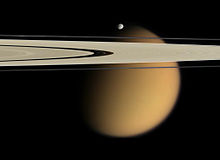
Epimetheus has a very high albedo of around 0.73, which means that it has a very bright surface that reflects 73% of the incident sunlight . On its surface, the acceleration due to gravity is 0.0078 m / s², which corresponds to about 8 ‰ of that on earth. The mean surface temperature of Epimetheus is estimated to be around −195 ° C (78 K ).
Emergence
Based on the crater density of its surface, it is concluded that it is a relatively old celestial body. Since Epimetheus and Janus are co-ordinate moons, it is assumed that they may have descended from a common original body that broke into two bodies due to a disturbance, for example a collision with another object. If this is the case, it must have happened in an early phase of Saturn's satellite system due to the crater density still observed today.
exploration
Epimetheus has an apparent magnitude of 14.5 m , which is 1: 912000 of the central planet. Since its discovery and confirmation in 1980 and the Voyager flyby flights, Epimetheus has been studied by earth-based telescopes and the Hubble space telescope , and its orbit parameters have thus been refined.
Epimetheus has so far been visited by three space probes , namely by the flyby probes Voyager 1 on November 12, 1980 and Voyager 2 on August 25, 1981 and the Saturn orbiter Cassini , which has orbited Saturn since July 1, 2004. Epimetheus was targeted by Cassini several times, so its size and shape, as well as its orbital parameters, are now fairly well known. Cassini's next flyby occurred during its 53rd orbit around Saturn on December 3, 2007, when the probe Epimetheus passed at a distance of 15,779 km. Some well-resolved recordings could be made.
On April 2, 2010, Cassini was able to record an occultation (from the probe's point of view) of the leading hemispheres of Janus by Epimetheus from a distance of 2.1 million km.
Provisional numbering
Due to the complicated history of the discovery of Epimetheus and Janus, Epimetheus received at least nine systematic numbering from the IAU , which could later be proven to be Epimetheus. At the time, this contributed significantly to the presumed too high number of Saturn's moons.
| designation | date | Reported by | IAUC |
|---|---|---|---|
| S / 1980 S 3 | March 6, 1980 | Dale P. Cruikshank | * 3457 |
| S / 1980 S 4 | March 6, 1980 | Dale P. Cruikshank | * 3457 |
| S / 1980 S 5 | March 6, 1980 | Bradford A. Smith / Harold J. Reitsema / Stephen M. Larson | * 3457 |
| S / 1980 S 8 | March 31, 1980 | Harris, AW / Gibson, J | * 3463 |
| S / 1980 S 11 | April 10, 1980 | Harold J. Reitsema / Bradford A. Smith / Stephen M. Larson | * 3466 |
| S / 1980 S 15 | April 28, 1980 | Christian Veillet | * 3470 |
| S / 1980 p 16 | April 28, 1980 | Christian Veillet | * 3470 |
| S / 1980 S 17 | April 28, 1980 | Christian Veillet | * 3470 |
| S / 1980 S 19 | May 9, 1980 | Audouin Dollfus / Serge Brunier | * 3474 |
media
Web links
- Emily Lakdawalla: The Orbital Dance of Epimetheus and Janus , description of the orbit exchange between Epimetheus and Janus on January 21, 2006 at www.planetary.org
- USGS list of named structures on Epimetheus
- IAUC 1987: Probable new Satellite of Saturn January 3, 1967 (discovery by A. Dollfus)
- IAUC 1991: Possible new Satellite of Saturn January 6, 1967 (discovery by R. Walker)
- IAUC 1995: Saturn X (Janus) February 1, 1967 (proposed name Janus)
- IAUC 3872: Satellites of Jupiter and Saturn September 30, 1983 (named Epimetheus, confirmation Janus)
- astronews: Picture of the day December 28, 2015
- astronews.com: Picture of the day: July 6, 2017
- Star stories podcast episode 30: Alternating planets from June 21, 2013
Individual evidence
- ↑ Paul Rincon: Saturn overtakes Jupiter as planet with most moons. BBC , October 7, 2019, accessed March 20, 2020 .
- ↑ Categories for Naming Features on Planets and Satellites - IAU Working Group for Planetary System Nomenclature (WGPSN)
- ↑ a b Emily Lakdawalla: The Orbital Dance of Epimetheus and Janus. The Planetary Society , February 7, 2006, accessed August 16, 2015 .
- ^ List of IAU Preliminary Designations of Natural Satellites. Retrieved February 20, 2011 .
| further inside | Saturn moons | further outside |
| Pandora |
Semi- major axis (km) Epimetheus 151.400 |
Janus |


